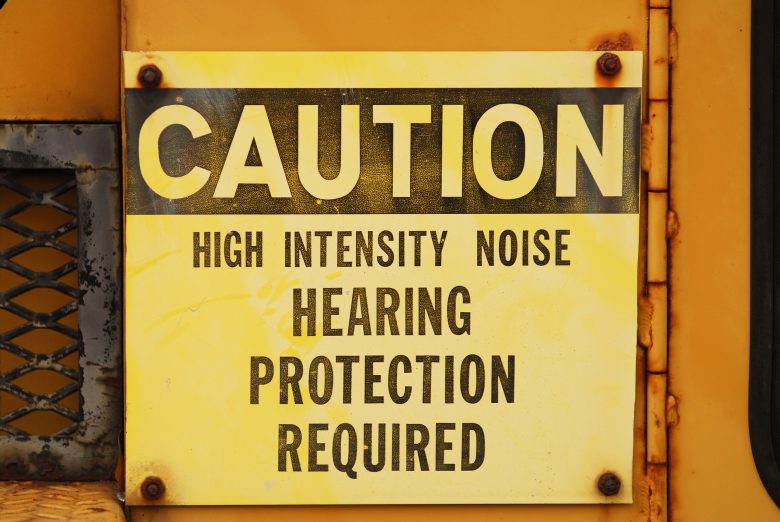Modern life is far from peaceful and quiet. Continuous exposure to sound levels above 85 decibels (dB) are harmful and not many people realize how many everyday sounds are louder than the recommended exposure limit—including lawnmowers, power tools, garbage disposals, blenders and food processors.
Workplaces can be especially loud and it’s not surprising that occupational hearing loss is one of the most common work-related illnesses in the US. In fact, according to the National Institute on Deafness and Other Communication Disorders (NIDCD) 6 percent of adults under the age of 70 in the U.S. have hearing loss in one or both ears from exposure to loud noises. Noise-induced hearing loss can be caused by one-time exposure to an intense sound or continuous exposure to loud and long-lasting noises.
Many industries require employees to perform their jobs in loud environments on a daily basis and sometimes the noise cannot be prevented. It is the employer’s responsibility to protect workers’ hearing and it’s vital that companies take the proper steps to prevent damage caused by noise.
The first step in reducing the risk of hearing loss is to thoroughly investigate noise levels in the workplace. Note which levels are dangerous or borderline harmful. Then, devise a strategy to address all the areas in the workplace affected by noise. This strategy should include preventative measures (engineering and administrative solutions) as well as hearing protection and a hearing conservation program, all recommended by OSHA.
Preventative measures
Preventative measures should aim to reduce or eliminate the hazardous exposure. Some engineering noise control solutions available to companies include the following:
- Purchase low-noise machinery or modify existing equipment to reduce noise levels.
- Invest in noise barriers and place them between the noise source and employees, or completely isolate the noise source.
- Research noise reduction solutions for conveyors, fans, hydraulic noises and others, which can provide a noise reduction of 10 dB. Options include removal, upgrading to new models or replacing existing equipment with less noisy alternative machines.
- Maintain and lubricate machinery—this can sometimes have a noticeable impact on the noise levels.
- Consider restricting worker presence to a safe distance from noisy equipment. It might take some rearranging, but if it’s possible to move loud equipment away from most workers then it could cut down on the levels of noise they’re exposed to. According to OSHA, in open space, doubling the distance between the source of noise and the worker decreases the noise by 6 dBA.
- If possible, arrange for noisy machinery to be operated during times when fewer people are exposed to the noise and limit the amount of time a worker spends operating excessively loud equipment.
- Establish quiet areas where employees’ hearing can rest (ideally a soundproof room).
Hearing protection
Addressing the source of noise hazards is the priority and reducing sounds by even a few decibels can dramatically lower the risk of hearing damage. However, it’s not always possible to control and reduce worker exposure to noise in a workplace so hearing protection must also be provided. Earmuffs, plugs and other hearing protection devices (HPDs) are a common last line of defense between workers and noise exposure:
- Provide workers with the right HPDs. Research all the available protective equipment before committing to one. Depending on the amount of noise and its duration, a mix of different solutions might be a good idea.
- Ensure that the equipment is provided with relevant, in-depth training. Workers need to know how to look after their HPD and how to use it correctly.
- Make sure workers know ear protective equipment is not optional. Supervisors should also encourage its use on a regular basis.
- Implement a hearing conservation program when noise exposure is 85 dBA or more for eight hours (general industry) or 90 dBA (construction).
Additional factors
Once you’ve addressed the physical and administrative aspects of noise hazards in the workplace, it’s time to deal with the human factors that can compromise your hearing protection program. If workers are regularly fatigued, rushed or complacent, this could make them more likely to ignore important safety measures like wearing HPDs. Providing human factors training could help workers recognize and address states of mind that can lead to noncompliant actions. It will also help workers look out for each other and speak up when they notice someone isn’t wearing mandatory personal protective equipment like earplugs.
Noise-induced hearing loss is a serious problem and it cannot be solved with a pair of earmuffs alone. It requires a plan that includes engineering solutions, administrative solutions, a hearing conservation program, and human factors reduction training. It takes work and dedication, but it’s a sound strategy to protect your workforce from a completely preventable and life-altering illness.

